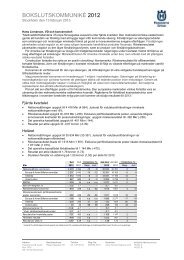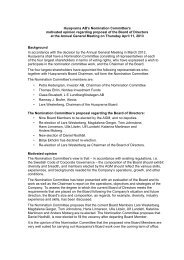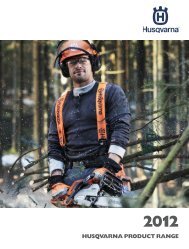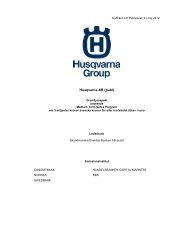Annual Report 2009 - Husqvarna Group
Annual Report 2009 - Husqvarna Group
Annual Report 2009 - Husqvarna Group
You also want an ePaper? Increase the reach of your titles
YUMPU automatically turns print PDFs into web optimized ePapers that Google loves.
Sustainable development <strong>Husqvarna</strong> <strong>Annual</strong> <strong>Report</strong> <strong>2009</strong> 121<br />
Social responsibility<br />
<strong>Husqvarna</strong>’s social responsibility comprises the development of personnel,<br />
the working environment, working conditions, respect for human rights,<br />
and a constructive social commitment.<br />
Employees<br />
In <strong>2009</strong>, <strong>Husqvarna</strong> had approximately 15,000 employees in<br />
more than 40 countries, of whom 85% were outside Sweden.<br />
<strong>Husqvarna</strong>’s goal is to offer an attractive global workplace.<br />
Motivated personnel comprise a prerequisite for the <strong>Group</strong>’s<br />
success. <strong>Husqvarna</strong> therefore maintains long-term programs<br />
for developing competent personnel.<br />
The workplace<br />
Key factors for creating motivation and commitment include<br />
promoting respect and tolerance at the work place, ensuring<br />
fair working conditions for personnel, maintaining a safe workplace,<br />
and offering opportunities for individual development.<br />
<strong>Husqvarna</strong> has defined basic overall principles for personnel<br />
relations, in the form of the <strong>Husqvarna</strong> People Process. It is<br />
designed to support managers regarding recruitment and<br />
selection, evaluation of performance, career development and<br />
remuneration. The process is also aimed at ensuring that people<br />
who contact the company are treated fairly. The <strong>Husqvarna</strong><br />
People Process, Code of Conduct, policies and guidelines<br />
comprise the foundation for this work. This information is<br />
available on the <strong>Group</strong>’s intranet.<br />
Talent management<br />
<strong>Husqvarna</strong> has a well-developed process for Talent Management<br />
that is aimed at evaluating, developing and ensuring<br />
access to future managers through both succession and mobility<br />
planning. The process starts with the annual individual<br />
review, during which goal-achievement and performance are<br />
evaluated, and new goals are defined for the coming period.<br />
In order to reinforce work on leadership development, in 2008<br />
the <strong>Group</strong> introduced a tool for 360-degree evaluation. It is<br />
used selectively to provide managers and key specialists with<br />
feedback on their leadership from colleagues and their immediate<br />
superiors.<br />
As <strong>Husqvarna</strong> attaches great importance to the ability to work<br />
as a team, teams are evaluated annually, see below on employee<br />
surveys. On the basis of evaluations of both teams and team<br />
members, personnel development is implemented mainly<br />
through on-the-job training, but also through other activities<br />
such as educational programs, coaching and feedback, job rotation<br />
and promotion to new positions within the <strong>Group</strong>.<br />
The process is driven by <strong>Group</strong> Staff Human Resources in<br />
close cooperation with local HR managers and line managers,<br />
who play an active role in this respect.<br />
Seasonal variations<br />
In light of the seasonal variations in <strong>Group</strong> sales, the number<br />
of temporary employees in production varies during the calendar<br />
year. It is normally highest during the first quarter and the<br />
start of the second, when most garden products are produced.<br />
The average annual share of temporary employees is normally<br />
somewhat more than 20%. The figure for <strong>2009</strong> was 15%. The<br />
large share of temporary employees involves relatively high<br />
personnel turnover, and training is required for some employees<br />
at the start of the season.<br />
Training for managers and project leaders<br />
<strong>Husqvarna</strong> offers three different <strong>Group</strong>-wide programs for<br />
leadership development. They are available at regular intervals<br />
during the year. The <strong>Husqvarna</strong> Next Level Leader program is<br />
aimed at managers on a level directly under senior management.<br />
The <strong>Husqvarna</strong> Leader Program is aimed at lower levels.<br />
The tailored <strong>Husqvarna</strong> Project Leader program is aimed at<br />
developing skills in project management and project leadership.<br />
More than 300 employees have participated in these<br />
programs since they were introduced in 2007.<br />
Average number of employees<br />
<strong>2009</strong> 2008<br />
North America 5,581 6,285<br />
Europe 6,469 7,151<br />
Rest of the World 2,980 2,284<br />
Total 15,030 15,720<br />
of whom women, % 36 36<br />
of whom men, % 64 64<br />
of whom white-collar, % 38 36<br />
of whom blue-collar, % 62 64<br />
Number of employees and<br />
sales by employee<br />
Number<br />
20,000<br />
15,000<br />
10,000<br />
5,000<br />
0<br />
05<br />
06<br />
07<br />
08 09<br />
Avarage number of employees<br />
Sales by employee, SEKm<br />
SEKm<br />
4<br />
3<br />
2<br />
1<br />
0<br />
Employees by geographical area<br />
Rest of the World, 20%<br />
North America, 37%<br />
Europe, 43%

















